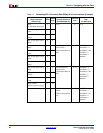
60 www.xilinx.com SPI-4.2 Lite v4.3 User Guide
UG181 June 27, 2008
Chapter 4: Designing with the Core
R
deasserted on the next clock cycle. The Sink FIFO read logic should then evaluate the
SnkFFEmpty_n signal to verify that there is no data in the FIFO in case an additional word
was simultaneously written into the FIFO. An example of this is provided with the SPI-4.2
Lite core in the Design Example (see the pl4_lite_fifo_loopback_read.v/vhd file.)
This example also illustrates the Sink FIFO Valid signal, which is asserted while there is
valid data on the data bus.
Sink FIFO Empty
Figure 4-5. illustrates the behavior of the Empty (SnkFFEmpty_n) status signal. As shown
in the waveform, the empty flag is asserted with the last word read out of the FIFO. In this
example, the Almost Empty flag is asserted prior to a read access being initiated. In this
case, there is one data word remaining in the FIFO. To access this word, assert the Sink
FIFO Read Enable (SnkFFRdEn_n) signal for one cycle.
Sink Almost Full
The behavior of Sink Almost Full flag (SnkAlmostFull_n) is dependent on the static
configuration signals SnkAFThresAssert and SnkAFThresNegate. When the
SnkAlmostFull_n flag is asserted, SnkAFThresAssert specifies the number of empty
FIFO locations available. For a 64-bit user interface, each FIFO location can contain up to
1/2 of a credit (8 bytes) worth of data from a single packet. For a 32-bit user interface, each
FIFO location can contain up to 1/4 of a credit (4 bytes) worth of data from a single packet.
SnkAFThresNegate specifies when the SnkAlmostFull_n flag is deasserted.
The number of bytes that can be written into the Sink SPI-4.2 interface after the Sink
Almost Full flag is asserted depends on received packet sizes, data patterns, and
Figure 4-4: Sink FIFO Almost Empty
Figure 4-5: Sink FIFO Empty
SnkFFData
SnkFFRdEn_n
SnkFFClk
SnkFFAlmostEmpty_n
SnkFFValid
SnkFFEmpty_n
SnkFFData
SnkFFRdEn_n
SnkFFClk
SnkFFAlmostEmpty_n
SnkFFValid
SnkFFEmpty_n


















